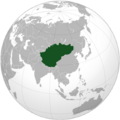First Turkic Khaganate
First Turkic Khaganate | |||||||||||||
|---|---|---|---|---|---|---|---|---|---|---|---|---|---|
| 552–603 | |||||||||||||
The First Turkic Khaganate at its greatest extent, in 576. | |||||||||||||
| Status | Khaganate (Nomadic empire) | ||||||||||||
| Capital | |||||||||||||
| Common languages | |||||||||||||
| Religion | Tengrism, Buddhism | ||||||||||||
| Demonym(s) | Türük Türk | ||||||||||||
| Qaghan | |||||||||||||
• 552 | Bumin Qaghan (first) | ||||||||||||
• 599–603 | Tardu (last) | ||||||||||||
| Yabgu | |||||||||||||
• 552–575 | Istämi (first) | ||||||||||||
• 575–599 | Tardu (last) | ||||||||||||
| Historical era | Post-classical | ||||||||||||
• Bumin Qaghan revolts against Rouran Khaganate | 542 | ||||||||||||
• Established | 552 | ||||||||||||
| 581 | |||||||||||||
• Brief re-unification | 603 | ||||||||||||
• Division of Western and Eastern Turkic Khaganates | 603 | ||||||||||||
| Area | |||||||||||||
| 557[8][9] | 6,000,000 km2 (2,300,000 sq mi) | ||||||||||||
| Population | |||||||||||||
• 6th century[10] | 3 million | ||||||||||||
| |||||||||||||
The First Turkic Khaganate, also referred to as the First Turkic Empire,[11] the Turkic Khaganate or the Göktürk Khaganate, was a Turkic khaganate established by the Ashina clan of the Göktürks in medieval Inner Asia under the leadership of Bumin Qaghan (d. 552) and his brother Istämi. The First Turkic Khaganate succeeded the Rouran Khaganate as the hegemonic power of the Mongolian Plateau and rapidly expanded their territories in Central Asia. The khaganate became the first Central Asian transcontinental empire from Manchuria to the Black Sea.[4]: 49 [12]
Although the Göktürks spoke a Siberian Turkic language directly antecedent to the Orkhon Turkic of the Second Turkic Khaganate, the First Khaganate's early official texts and coins were written in Sogdian.[5][6] It was the first Turkic state to use the name Türk politically.[13] The Old Turkic script was invented at the first half of the sixth century.[14][15]
The Khaganate collapsed in 603, after a series of conflicts and civil wars which separated the polity into the Eastern Turkic Khaganate and Western Turkic Khaganate. The Tang China conquered the Eastern Turkic Khaganate in 630 and the Western Turkic Khaganate in 657 in a series of military campaigns. The Second Turkic Khaganate emerged in 682 and lasted until 744, when it was overthrown by the Uyghur Khaganate.
History
[edit]Origin
[edit]The origins of the Turkic Khanate trace back to 546, when Bumin Qaghan made a preemptive strike against the Uyghur and Tiele groups planning a revolt against their overlords, the Rouran Khanate. For this service he expected to be rewarded with a Rouran princess, thus marrying into the royal family. However, the Rouran khagan, Yujiulü Anagui, sent an emissary to Bumin to rebuke him, saying, "You are my blacksmith slave. How dare you utter these words?" As Anagui's "blacksmith slave" (Chinese: 鍛奴; pinyin: duànnú) comment was recorded in Chinese chronicles, some claim that the Göktürks were indeed blacksmith servants for the Rouran elite,[16][17][18][19] and that "blacksmith slavery" may have indicated a form of vassalage within Rouran society.[20] According to Denis Sinor, this reference indicates that the Türks specialized in metallurgy, although it is unclear if they were miners or, indeed, blacksmiths.[21][22] Whatever the case, that the Turks were "slaves" need not be taken literally, but probably represented a form of vassalage, or even unequal alliance.[23]

A disappointed Bumin allied with the Western Wei against the Rouran, their common enemy, by marrying Princess Changle. In 552, Bumin defeated Anagui and his forces north of Huaihuang (modern Zhangjiakou, Hebei).[26][27]
Western expansion
[edit]Having excelled both in battle and diplomacy, Bumin declared himself Illig Khagan of the new khanate at Otukan, but died only months later. His son, Muqan Qaghan, defeated the Hephthalite Empire.[28]
Bumin's brother Istämi (d. 576) bore the title "Yabgu of the West". This western branch of the Ashina clan was de facto independent while the eastern khagan was formally recognized as the senior. In 557, Istämi forged an alliance with the Sassanid Empire of Iran to defeat and destroy the Hephthalites, who were allies of the Rouran.[29] This war tightened the Ashina clan's grip on the Silk Road. The alliance with China was further reinforced in 568 through the marriage of the Turkic princess Ashina, daughter of Muqan Qaghan, with Emperor Wu of the Xianbei-led Chinese Northern Zhou dynasty.
The appearance of the Pannonian Avars in the West has been interpreted as a nomadic faction fleeing the westward expansion of the Göktürks, although the specifics are a matter of irreconcilable debate given the lack of clear sources and chronology. Rene Grousset links the Avars with the downfall of the Hephthalites rather than the Rouran,[30] while Denis Sinor argues that Rouran-Avar identification is "repeated from article to article, from book to book with no shred of evidence to support it".[31]
Istämi's policy of western expansion brought the Göktürks into Europe.[32] In 576 the Göktürks crossed the Kerch Strait into the Crimea. Five years later they laid siege to Chersonesus; their cavalry kept roaming the steppes of Crimea until 590.[33] As for the southern borders, they were drawn south of the Amu Darya, bringing the Ashina into conflict with their former allies, the Sasanian Empire. In 589, the Sasanian Empire attacked and defeated the Türks.[34] Much of Bactria (including Balkh) remained a dependency of the Ashina until the end of the century.[33]
Relations with the Byzantine Empire
[edit]The Göktürks played a major role with the Byzantine Empire's relationship with the Persian Sasanian Empire.[36] The first contact is believed to be 563 and relates to the incident in 558 where the slaves of the Turks (the Pannonian Avars) ran away during their war with the Hephthalites.[36][37]
The second contact occurred when Maniah, a Sogdian diplomat, convinced Istämi (also known as Silziboulos in Greek writings[38]) of the Göktürks to send an embassy directly to the Byzantine Empire's capital Constantinople, which arrived in 568 and offered silk as a gift to emperor Justin II and where they discussed an alliance. In 569 an embassy led by Zemarchus occurred which was well received and likely solidified their alliance for war.[36][39]
Another set of embassies occurred in 575–576 led by Valentine which were received with hostility by Turxanthos due to alleged treachery.[37] They required the members of the Byzantine delegation at the funeral of Istämi to lacerate their faces to humiliate them.[40] The subsequent hostility shown by the new ruler Tardu[40][41] would be matched in Byzantine writings.[42] With the insults reflecting a breakdown of the alliance, the likely cause is that the anger was due to the Turks not having their expectations met from their agreements and realising they were being used when they no longer aligned with the current goals of the Byzantine Empire (who correspondingly lacked trust in the Turks as partners).[36]
-
Göktürk petroglyphs from Mongolia (6th to 8th century).[43]
-
Turkic horsemen with long hair on the tomb of a Sogdian trader, the Miho funerary couch. Circa 570 CE. Northern Dynasties, China.[44][25]
-
The Sogdian trader An Jia with a Turkic Chieftain in his yurt. 579 CE, Tomb of An Jia, Xi’an, China.
-
The Sogdian trader An Jia (right) brokering an alliance with Turks (left). 579 CE, Tomb of An Jia, Xi’an, China.
Civil war
[edit]When the fourth ruler of the khaganate, Taspar Qaghan, died in 581, the realm split in two over the succession.[27] He had willed the title of khagan to Muqan's son Apa Qaghan, but the high council appointed Ishbara Qaghan instead. Factions formed around both leaders. Before long, four rivals claimed the title. They were successfully played off against each other by the Sui and Tang dynasties.[citation needed]
Istämi's son, Tardu the leader of the western Türks, made a bid for total independence.[27] He now seized the title and led an army east to claim the seat of imperial power, Otukan.[citation needed]
In order to buttress his position, Ishbara of the Eastern Khaganate, acknowledged the suzerainty of Emperor Yang of Sui in order to seek their protection.[27] Tardu attacked Chang'an, the Sui capital, around 600, demanding Emperor Yangdi end his interference in the civil war. In retaliation, Sui diplomacy successfully incited a revolt of Tardu's Tiele vassals, which led to the end of Tardu's reign in 603. Among the dissident tribes were the Uyghurs and Xueyantuo.[citation needed]
Eastern Turkic Khaganate
[edit]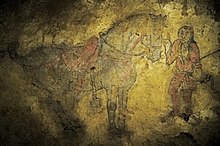
The civil war left the empire divided into eastern and western parts. The eastern part, still ruled from Otukan, remained in the orbit of the Sui and retained the name Göktürk. The Shibi Khan (609–619) and Illig Qaghan (620–630) attacked the Central Plain at its weakest moment during the transition between the Sui and Tang. Shibi Khan's surprise attack against Yanmen Commandery during an imperial tour of the northern frontier almost captured Emperor Yang, but his ethnic Han wife Princess Yicheng—who had been well treated by Empress Xiao during an earlier visit—sent a warning ahead, allowing the emperor and empress time to flee to the commandery seat at present-day Daixian in Shanxi.[49] This was besieged by the Turkic army on September 11, 615,[50][51] but Sui reinforcements and a false report from Princess Yicheng to her husband about a northern attack on the khaganate caused him to lift the siege before its completion.[49]
In 626, Illig Qaghan took advantage of the Xuanwu Gate Incident and drove on to Chang'an. On September 23, 626,[50] Illig Qaghan and his iron cavalry reached the bank of the Wei River north of Bian Bridge (in present-day Xianyang, Shaanxi). On September 25, 626,[50] Tang Taizong allied with Iligh Khan and met with the khan on the border bridge, Tang Taizong accused Iligh Khan of crossing the border, the khan saw that Taizong was imposing, mistakenly thought that the reinforcements of the Tang Dynasty had arrived, plus two years ago, he had seen Li Shimin, who was still the crown prince at that time, in Binzhou (彬州), and was asked to duel. The khan was afraid and agreed to retreat in an alliance, which is called the Weishui Alliance (渭水之盟) or the Alliance of Bian Qiao (便橋會盟 / 便桥会盟).[52] On the third day after the meeting, the khan sent 3,000 horses and 10,000 sheep to the border to be prepared as compensation for the Tang dynasty, which Emperor Taizong did not accept, believing that this was too little.[53] All in all, 67 incursions into China proper were recorded.[33]
Before mid-October 627, heavy snows on the Mongolian-Manchurian grassland covered the ground to a depth of several feet, preventing the nomads' livestock from grazing and causing a massive die-off among the animals.[54] According to the New Book of Tang, in 628, Taizong mentioned that "There has been a frost in midsummer. The sun had risen from same place for five days. The moon had had the same light level for three days. The field was filled with red atmosphere (dust storm)."[55]
Illig Qaghan was brought down by a revolt of his Tiele vassal tribes (626–630), allied with Emperor Taizong of Tang. This tribal alliance figures in Chinese records as the Huihe (Uyghur).[56]
On March 27, 630,[50] a Tang army under the command of Li Jing defeated the Eastern Turkic Khaganate under the command of Illig Qaghan at the Battle of Yinshan (陰山之戰 / 阴山之战).[57][58][59] Illig Qaghan fled to Ishbara Shad, but on May 2, 630[60] Zhang Baoxiang's army advanced to Ishbara Shad's headquarters. Illig Qaghan was taken prisoner and sent to Chang'an.[59] The Eastern Turkic Khaganate collapsed and was incorporated into the Jimi system of Tang. Emperor Taizong said, "It's enough for me to compensate my dishonor at Wei River."[58]
Western Turkic Khaganate
[edit]
The Western khagan Sheguy and Tong Yabghu Qaghan constructed an alliance with the Byzantine Empire against the Sasanian Empire and defeated the Sasanians in 628, successfully restoring the southern borders along the Tarim and Amu Darya rivers.[63] Their capital was Suyab in the Chu River valley, about 6 km south east of modern Tokmok. In 627 Tung Yabghu, assisted by the Khazars and Emperor Heraclius, launched a massive invasion of Transcaucasia which culminated in the taking of Derbent and Tbilisi (see the Third Perso-Turkic War for details). In April 630 Tung's deputy Böri Shad sent the Göktürk cavalry to invade Armenia, where his general Chorpan Tarkhan succeeded in routing a large Persian force. Tung Yabghu's murder in 630 forced the Göktürks to evacuate Transcaucasia.[citation needed]
The Western Turkic Khaganate was modernized through an administrative reform of the Ashina clan (reigned 634–639) and came to be known as the Onoq.[64] The name refers to the "ten arrows" that were granted by the khagan to ten leaders (shads) of its two constituent tribal confederations, the Duolu (five churs) and Nushibi (five irkins), whose lands were divided by the Chui River.[64] The division fostered the growth of separatist tendencies. Soon, chieftain Kubrat of the Dulo clan, whose relation ship with the Duolu is possible but not proven, seceded from the Khaganate. The Tang dynasty campaigned against the khaganate and its vassals, the oasis states of the Tarim Basin. The Tang campaign against Karakhoja in 640 led to the retreat of the Western Turks, who were defeated during the Tang campaigns against Karasahr in 644 and the Tang campaign against Kucha in 648,[65][66] leading to the 657 conquest of the Western Turks by the Tang general Su Dingfang.[67] Emperor Taizong of Tang was proclaimed Khagan of the Göktürks in 658.[63]
Tang vassals
[edit]The Tang retained a member of the Ashina clan as a puppet khagan of the Türks. In 639, Ashina Jiesheshuai attempted to kill Emperor Taizong of Tang but failed, causing him to relocate the Türks. These khagans were not well respected among their peers and a new group of leaders known as the Turgesh were established by 699.[68]
In 657, the Tang emperor could impose indirect rule along the Silk Road as far as modern-day Iran. He installed two khagans to rule the ten arrows (tribes) of Göktürks. Five arrows of Tulu (咄陆) were ruled by khagans bearing the title of Xingxiwang (興昔亡可汗) while five arrows of Nushipi (弩失畢可汗) were ruled by Jiwangjue (繼往絕可汗). Five Tulu corresponded to the area east of Lake Balkash while five arrows of Nushipi corresponded to the land east of the Aral Sea. Göktürks now carried Chinese titles and fought by their side in their wars. The era spanning from 657 to 699 in the steppes was characterized by numerous rulers – weak, divided, and engaged in constant petty wars under the Anxi Protectorate until the rise of Turgesh.

The Second Turkic Khaganate was founded by Ilterish Qaghan after rebelling against the Tang in 681.[71]
Genetics
[edit]The population of the First Turkic Khaganate displayed genetic heterogeneity. Türk remains analysed displayed on average c. 62% Ancient Northeast Asian, c. 27% Western Steppe Herders, and c. 11% BMAC-associated ancestry. A sample belonging to the Ashina tribe, the ruling clan of the Göktürks, was found to be nearly entirely derived from Ancient Northeast Asians (96-98%) and also displayed affinity for the Slab-grave culture. According to the authors, these findings "once again validates a cultural diffusion model over a demic diffusion model for the spread of Turkic languages" and refutes "the western Eurasian origin and multiple origin hypotheses".[72]
Gallery
[edit]-
Shahnameh illustration of Bahram Chobin and Bagha Qaghan fighting.
See also
[edit]| History of the Turkic peoples pre–14th century |
|---|
 |
| History of Central Asia |
|---|
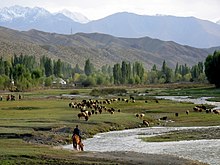 |
- Göktürk family tree
- Turks in the Tang military
- Horses in East Asian warfare
- Kangly
- Orkhon inscription
- Qaghans of the Turkic khaganates
- Timeline of the Turkic peoples (500–1300)
- Ashide
References
[edit]- ^ "The tamga of the royal clan of the first Turkish empire was a neatly drawn lineal picture of an ibex", Kljastornyj, 1980, p. 93
- ^ Sinor 1969, p. 101.
- ^ Peter Roudik (2007). The History of the Central Asian Republics. p. 24.
- ^ a b Golden, Peter B. (2011). Central Asia in World History.
- ^ a b Roux 2000, p. 79.
- ^ a b Baratova 2005.
- ^ Vovin 2019, p. 133.
- ^ Turchin, Peter; Adams, Jonathan M.; Hall, Thomas D. (December 2006). "East–West Orientation of Historical Empires". Journal of World-Systems Research. 12 (2): 222. ISSN 1076-156X. Retrieved 16 September 2016.
- ^ Taagepera, Rein (1979). "Size and Duration of Empires: Growth-Decline Curves, 600 B.C. to 600 A.D.". Social Science History. 3 (3/4): 129. doi:10.2307/1170959. JSTOR 1170959.
- ^ Karatay, Osman. Göktürk Çağı Türk Nüfusu Üzerine Düşünceler. 18. Türk Tarih Kongresi, 1-4 Ekim 2018 Ankara.
- ^ Kwanten, Luc (1979). Imperial Nomads: A History of Central Asia, 500–1500. p. 35. OCLC 4193301.
- ^ Taşağıl, Ahmet (2021). Türk Model Devleti Gök Türkler. Bilge Kültür Sanat. ISBN 9786059521598.
- ^ West, Barbara A. (19 May 2010). Encyclopedia of the Peoples of Asia and Oceania. Infobase Publishing. p. 829. ISBN 978-1-4381-1913-7.
The first people to use the ethnonym Turk to refer to themselves were the Turuk people of the Gokturk Khanate in the mid sixth-century
- ^ Tryjarski, E. (2002). "Runes and runelike scripts of Eurasian area. Part 1". Archivum Ottomanicum. 20. Mouton: 49.
- ^ de Laet, Sigfried J.; Herrmann, Joachim (1996). History of Humanity: From the seventh century B.C. to the seventh century A.D. p. 478.
- ^ 馬長壽, 《突厥人和突厥汗國》, 上海人民出版社, 1957, p. 10–11 (in Chinese)
- ^ 陳豐祥, 余英時, 《中國通史》, 五南圖書出版股份有限公司, 2002, ISBN 978-957-11-2881-8, p. 155 (in Chinese)
- ^ Gao Yang, "The Origin of the Turks and the Turkish Khanate", X. Türk Tarih Kongresi: Ankara 22 – 26 Eylül 1986, Kongreye Sunulan Bildiriler, V. Cilt, Türk Tarih Kurumu, 1991, s. 731. (in English)
- ^ Oğuz, Burhan (1976). "«Demirci köle» olmaktan kurtulup reisleri Bumin'e". Türkiye halkının kültür kökenleri: Giriş, beslenme teknikleri (in Turkish). İstanbul: Matbaası. p. 147. ISBN 9789758586226.
- ^ Moses, Larry W. (1976). "Relations with the Inner Asian Barbarian". In Perry, John Curtis; Smith, Bardwell Leith (eds.). Essays on Tʻang Society. Leiden: Brill Archive. p. 65. ISBN 978-90-04-04761-7.
'Slave' probably meant vassalage to the Juan Juan [=Rouran or Ruanruan] qaghan, whom they [the Türks] served in battle by providing iron weapons, and also marching with the qaghan's armies.
- ^ Denis Sinor, Inner Asia: history-civilization-languages: a syllabus, Routledge, 1997, ISBN 978-0-7007-0380-7, p. 26. Contacts had already begun in 545 A.D. between the so-called "blacksmith-slave" Türk and certain of the kingdoms of north China,
- ^ Denis Sinor, ibid, p. 101. 'Beyond A-na-kui's disdainful reference to his "blacksmith slaves" there is ample evidence to show that the Turks were indeed specializing in metallurgy, though it is difficult to establish whether they were miners or rather blacksmiths.' (in English)
- ^ Nachaeva (2011)
- ^ Baumer, Christoph (18 April 2018). History of Central Asia, The: 4-volume set. Bloomsbury Publishing. p. 228. ISBN 978-1-83860-868-2.
- ^ a b Yatsenko, Sergey A. (August 2009). "Early Turks: Male Costume in the Chinese Art". Transoxiana. 14.
- ^ Linghu Defen et al., Book of Zhou, Vol. 50. (in Chinese)
- ^ a b c d Kamola 2023, p. 13.
- ^ Li Yanshou (李延寿), History of Northern Dynasties, Vol. 99.
- ^ Kamola 2023, p. 13-14.
- ^ Grousset (1970, p. 82)
- ^ History and historiography of the Nomad Empires of Central Eurasia. D Sinor. Acta Orientalia Academiae Scientarum Hung. 58 (1) 3 – 14, 2005
- ^ Walter Pohl, Die Awaren: ein Steppenvolk im Mitteleuropa, 567–822 n. Chr, C.H.Beck (2002), ISBN 978-3-406-48969-3, p. 26–29.
- ^ a b c Grousset 81.
- ^ Kamola 2023, p. 14.
- ^ Haug, Robert (27 June 2019). The Eastern Frontier: Limits of Empire in Late Antique and Early Medieval Central Asia. Bloomsbury Publishing. p. 65. ISBN 978-1-78831-722-1.
The collapse of the Hephthalite domains made neighbours of the Türk Khāqānate and the Sasanian Empire, both sharing a border that ran the length of the River Oxus. Further Turkish expansion to the west and around the Caspian Sea saw them dominate the western steppes and its people and extend this frontier down to the Caucasus where they also shared a border with the Sasanians. Khusrow is noted at the time for improving the fortifications on either side of the Caspian, Bāb al-Abwāb at Derbent and the Great Wall of Gorgān.
- ^ a b c d Qiang, Li; Kordosis, Stefanos (2018). "The Geopolitics on the Silk Road: Resurveying the Relationship of the Western Türks with Byzantium through Their Diplomatic Communications". Medieval Worlds. medieval worlds (8): 109–125. doi:10.1553/medievalworlds_no8_2018s109. ISSN 2412-3196.
- ^ a b Sinor, Dennis (1996). The First Türk Empire (553–682). UNESCO. pp. 327–332. ISBN 978-92-3-103211-0. Retrieved 2022-01-23.
- ^ Eliot, C. (1908). Turkey in Europe. United Kingdom: E. Arnold. Page 76
- ^ Whittow, Mark (2018-04-26), Di Cosmo, Nicola; Maas, Michael (eds.), "Byzantium's Eurasian Policy in the Age of the Türk Empire", Empires and Exchanges in Eurasian Late Antiquity (1 ed.), Cambridge University Press, pp. 271–286, doi:10.1017/9781316146040.021, ISBN 978-1-316-14604-0, retrieved 2022-01-23,
"Mark Whittow directly suggests that this embassy reached an agreement for a joint attack on the Persians planned for 573.
- ^ a b Menander, Protector, activeth century (1985). The history of Menander the Guardsman. R. C. Blockley. Liverpool, Great Britain: F. Cairns. pp. 173–177. ISBN 0-905205-25-1. OCLC 14355502.
{{cite book}}: CS1 maint: multiple names: authors list (link) - ^ Peter B. Golden (2011). Central Asia in World History. p. 39.
At a subsequent embassy, Tardu yelled at Valentine in anger, venting his rage saying "Are you not those very Romans who use ten tongues and lie with all of them?
- ^ Maurice, Strategikon, ed. Dennis and Gamillscheg, 360;Maurice's Strategikon : handbook of Byzantine military strategy. Emperor of the East Maurice, Orbicius, George T. Dennis. Philadelphia. 1984. p. 116. ISBN 0-8122-7899-2. OCLC 9575024.
They [the Turks] were superstitious, treacherous, foul, faithless, possessed by an insatiate desire for riches. They scorn their oath, do not observe agreements, and are not satisfied by gifts. Even before they accept the gift, they are making plans for treachery and betrayal of their agreements. They are clever at estimating suitable opportunities to do this and taking prompt advantage of them. They prefer to prevail over their enemies not so much by force as by deceit, surprise attacks, and cutting off supplies.
{{cite book}}: CS1 maint: location missing publisher (link) CS1 maint: others (link) - ^ ALTINKILIÇ, Dr. Arzu Emel (2020). "Göktürk giyim kuşamının plastik sanatlarda değerlendirilmesi" (PDF). Journal of Social and Humanities Sciences Research: 1101–1110. Archived from the original (PDF) on 2020-10-24. Retrieved 2020-10-22.
- ^ Inagaki, Hajime. Galleries and Works of the MIHO MUSEUM. Miho Museum. p. 121, panel 8.
- ^ ALTINKILIÇ, Dr. Arzu Emel (2020). "Göktürk giyim kuşamının plastik sanatlarda değerlendirilmesi" (PDF). Journal of Social and Humanities Sciences Research: 1101–1110.
- ^ Narantsatsral, D. "THE SILK ROAD CULTURE AND ANCIENT TURKISH WALL PAINTED TOMB" (PDF). The Journal of International Civilization Studies.
- ^ Cosmo, Nicola Di; Maas, Michael (26 April 2018). Empires and Exchanges in Eurasian Late Antiquity: Rome, China, Iran, and the Steppe, ca. 250–750. Cambridge University Press. pp. 350–354. ISBN 978-1-108-54810-6.
- ^ Baumer, Christoph (18 April 2018). History of Central Asia, The: 4-volume set. Bloomsbury Publishing. pp. 185–186. ISBN 978-1-83860-868-2.
- ^ a b Xiong (2006), pp. 63–4
- ^ a b c d 武德九年 八月癸未 Academia Sinica Archived 2010-05-22 at the Wayback Machine (in Chinese)
- ^ Sima Guang, Zizhi Tongjian, Vol. 182. (in Chinese)
- ^ 司, 马光 (1086). 《资治通鉴·卷第一百九十一·唐纪七》. In 1086, the government of Emperor Shenzong of Song. pp. 《资治通鉴·卷第一百九十一·唐纪七》.
上自出玄武门,与高士廉、房玄龄等立骑径诣渭水上,与颉利隔水而语,责以负约。突厥大惊,皆下马罗拜。俄而诸军继至,旌甲蔽野,颉利见执失思力不返,而上挺身轻出,军容甚盛,有惧色。上麾诸军使却而布陈,独留与颉利语。萧瑀以上轻敌,叩马固谏,上曰:"吾筹之已熟,非卿所知。突厥所以敢倾国而来,直抵郊甸者,以我国内有难,朕新即位,谓我不能抗御故也。我若示之心弱,闭门拒守,虏必放兵大掠,不可复制。故朕轻骑独出,示若轻之;又震曜军容,使之必战;出虏不意,使之失图。虏入我地既深,必有惧心,故与战则克,与和则固矣。制服突厥,在此一举,卿第观之!"
- ^ 刘, 昫 (945). 《旧唐书》本纪第二. Later Jin Shi Jingtang government. pp. 《旧唐书》本纪第二.
乙酉,又幸便桥,与颉利刑白马设盟,突厥引退。九月丙戌,颉利献马三千匹、羊万口
- ^ David Andrew Graff, Medieval Chinese warfare, 300–900, Routledge, 2002, ISBN 978-0-415-23955-4, p. 186.
- ^ Ouyang Xiu, New Book of Tang, Vol. 215-I (in Chinese)
- ^ Liu 劉, Xu 昫 (945). Old Book of Tang 舊唐書 Vol.194 & Vol.195.
- ^ Old Book of Tang, Vol. 3. (in Chinese)
- ^ a b Ouyang Xiu et al., New Book of Tang, Vol. 93. (in Chinese)
- ^ a b Sima Guang, Zizhi Tongjian, Vol. 193. (in Chinese)
- ^ 貞觀四年 三月庚辰
- ^ Baumer, Christoph (18 April 2018). History of Central Asia, The: 4-volume set. Bloomsbury Publishing. p. 243. ISBN 978-1-83860-868-2.
- ^ Grenet, Frantz (2004). "Maracanda/Samarkand, une métropole pré-mongole". Annales. Histoire, Sciences Sociales. 5/6: Fig. B.
- ^ a b Kamola 2023, p. 15.
- ^ a b Gumilev 238.
- ^ Grousset 1970, pp. 99–100.
- ^ Wechsler 1979, pp. 225–228.
- ^ Skaff 2009, p. 183.
- ^ Kamola 2023, p. 15-16.
- ^ a b c d Bemmann, Jan; Brosseder, Ursula. "A Long Standing Tradition – Stelae in the Steppes with a Special Focus on the Slab Grave Culture". Actual Problems of Archaeology and Ethnology of Central Asia. ISBN 978-5-7925-0494-3.
Current research shows that only during the time of the Turk qaghanates (552-630, 682-742 CE) were different types of stelae widely used in Inner Asia: there are rows of balbals in association with ritual sites, kamennye babas in association with memorials, and also inscription stelae were erected at important Turkic ritual sites [e.g., Kubarev, 1984; Voitov, 1996; Baiar, 1997].
- ^ a b c d Bazarov, B. V.; Institut mongolovedenii︠a︡, buddologii i tibetologii (Rossiĭskai︠a︡ akademii︠a︡ nauk. Sibirskoe otdelenie), eds. (2017). Aktualʹnye voprosy arkheologii i ėtnologii T︠S︡entralʹnoĭ Azii: materialy II mezhdunarodnoĭ nauchnoĭ konferent︠s︡ii, Ulan-Udė, 4-6 dekabri︠a︡ 2017 [Actual problems of archaeology and ethnology of Central Asia: materials of the II International conference (Ulan-Ude, 4-6th December, 2017)]. Ulan-Udė: Izd-vo BNT︠s︡ SO RAN. ISBN 978-5-7925-0494-3.
- ^ Barfield 1989, p. 149.
- ^ Yang, Xiao-Min; Meng, Hai-Liang; Zhang, Jian-Lin; Yu, Yao; Allen, Edward; Xia, Zi-Yang; Zhu, Kong-Yang; Du, Pan-Xin; Ren, Xiao-Ying; Xiong, Jian-Xue; Lu, Xiao-Yu; Ding, Yi; Han, Sheng; Liu, Wei-Peng; Jin, Li (November 2023). "Ancient genome of Empress Ashina reveals the Northeast Asian origin of Göktürk Khanate". Journal of Systematics and Evolution. 61 (6): 1056–1064. doi:10.1111/jse.12938. ISSN 1674-4918.
External links
[edit]Bibliography
[edit]- Asimov, M.S. (1998), History of civilizations of Central Asia Volume IV The age of achievement: A.D. 750 to the end of the fifteenth century Part One The historical, social and economic setting, UNESCO Publishing
- Baratova, Larissa (2005). "Turko-Sogdian Coinage". Encyclopedia Iranica.
- Barfield, Thomas (1989), The Perilous Frontier: Nomadic Empires and China, Basil Blackwell
- Benson, Linda (1998), China's last Nomads: the history and culture of China's Kazaks, M.E. Sharpe
- Bregel, Yuri (2003), An Historical Atlas of Central Asia, Brill
- Bosworth, Clifford Edmund (2000), The Age of Achievement: A.D. 750 to the End of the Fifteenth Century – Vol. 4, Part II : The Achievements (History of Civilizations of Central Asia), UNESCO Publishing
- Bughra, Imin (1983), The history of East Turkestan, Istanbul: Istanbul publications
- Drompp, Michael Robert (2005), Tang China And The Collapse Of The Uighur Empire: A Documentary History, Brill
- Golden, Peter B. (2011), Central Asia in World History, Oxford University Press
- Grousset, René (1970). The empire of the steppes : a history of central Asia. Rutgers University Press. ISBN 978-0-8135-1304-1.
- Haywood, John (1998), Historical Atlas of the Medieval World, AD 600–1492, Barnes & Noble
- Jeong, Choongwon; Wang, Ke; Wilkin, Shevan; Taylor, William Timothy Treal; Miller, Bryan K.; Bemmann, Jan H.; Stahl, Raphaela; Chiovelli, Chelsea; Knolle, Florian; Ulziibayar, Sodnom; Khatanbaatar, Dorjpurev; Erdenebaatar, Diimaajav; Erdenebat, Ulambayar; Ochir, Ayudai; Ankhsanaa, Ganbold (2020-11-12). "A Dynamic 6,000-Year Genetic History of Eurasia's Eastern Steppe". Cell. 183 (4): 890–904.e29. doi:10.1016/j.cell.2020.10.015. ISSN 0092-8674. PMC 7664836. PMID 33157037.
- Kamola, Stefan (2023), I Made Him Praiseworthy: The Kül Tegin Inscription in World History, De Gruyter
- Latourette, Kenneth Scott (1964), The Chinese, their history and culture, Volumes 1–2, Macmillan
- Mackerras, Colin (1990), "Chapter 12 – The Uighurs", in Sinor, Denis (ed.), The Cambridge History of Early Inner Asia, Cambridge University Press, pp. 317–342, ISBN 0-521-24304-1
- Millward, James A. (2007), Eurasian Crossroads: A History of Xinjiang, Columbia University Press
- Mackerras, Colin (1972). The Uighur Empire According to the T'ang Dynastic Histories: A Study in Sino-Uighur Relations. Australian National University Press. pp. 744–840. ISBN 0-7081-0457-6.
- Nachaeva, Ekaterina (2011). "The "Runaway" Avars and Late Antique Diplomacy". In Ralph W. Mathisen; Danuta Shanzer (eds.). Romans, Barbarians, and the Transformation of the Roman World: Cultural Interaction and the Creation of Identity in Late Antiquity. Ashgate.
- Roux, Jean-Paul (2000). Histoire des Turcs (in French). Fayard.
- Sinor, Denis (1969). Inner Asia: History-Civilization-Languages. Indiana University Press.
- Sinor, Denis (1990), The Cambridge History of Early Inner Asia, Cambridge University Press, ISBN 978-0-521-24304-9
- Skaff, Jonathan Karem (2009). Nicola Di Cosmo (ed.). Military Culture in Imperial China. Harvard University Press. ISBN 978-0-674-03109-8.
- Vovin, A. (2019). "Groping in the Dark: The First Attempt to Interpret the Bugut Brahmi Inscription". Journal Asiatique. 307 (1): 121–134.
- Wechsler, Howard J. (1979). "T'ai-Tsung (Reign 626–49): The Consolidator". In Denis Twitchett; John Fairbank (eds.). The Cambridge History of China, Volume 3: Sui and T'ang China Part I. Cambridge University Press. ISBN 978-0-521-21446-9.
- Xiong, Victor Cunrui (2006), Emperor Yang of the Sui Dynasty: His Life, Times, and Legacy, Albany: State University of New York Press, ISBN 9780791482681.
- Xiong, Victor (2008), Historical Dictionary of Medieval China, United States of America: Scarecrow Press, Inc., ISBN 978-0810860537
- 薛宗正 (1992). 突厥史. 中国社会科学出版社. ISBN 978-7-5004-0432-3. OCLC 28622013.

![Tamga of Ashina tribe.[1] of First Turkic Khaganate](http://up.wiki.x.io/wikipedia/commons/thumb/a/a3/Tamga_of_Ashina.png/85px-Tamga_of_Ashina.png)


![Göktürk petroglyphs from Mongolia (6th to 8th century).[43]](http://up.wiki.x.io/wikipedia/commons/thumb/6/6e/Tyurki.jpg/200px-Tyurki.jpg)
![Turkic horsemen with long hair on the tomb of a Sogdian trader, the Miho funerary couch. Circa 570 CE. Northern Dynasties, China.[44][25]](http://up.wiki.x.io/wikipedia/commons/thumb/2/23/Turkic_horsemen_with_unidentifiable_ambassadors_on_top.jpg/93px-Turkic_horsemen_with_unidentifiable_ambassadors_on_top.jpg)

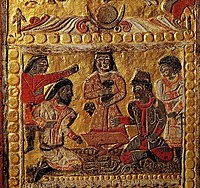

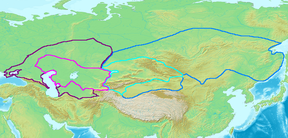



![Turkic Balbal, Tuva, Siberia.[69][70]](http://up.wiki.x.io/wikipedia/commons/thumb/f/f6/Babal%2C_Kyzyl_-_capital_of_Tuva_-_Siberia.jpg/80px-Babal%2C_Kyzyl_-_capital_of_Tuva_-_Siberia.jpg)
![Turkic Balbal, Tuva, Siberia.[69][70]](http://up.wiki.x.io/wikipedia/commons/thumb/9/94/Kyzyl_-_capital_of_Tuva_-_Siberia_-_16760782050.jpg/81px-Kyzyl_-_capital_of_Tuva_-_Siberia_-_16760782050.jpg)
![Turkic Balbal, Kyrgyzstan.[69][70]](http://up.wiki.x.io/wikipedia/commons/thumb/b/b9/Burana%2C_Kyrgyzstan_%2829724205397%29.jpg/70px-Burana%2C_Kyrgyzstan_%2829724205397%29.jpg)



